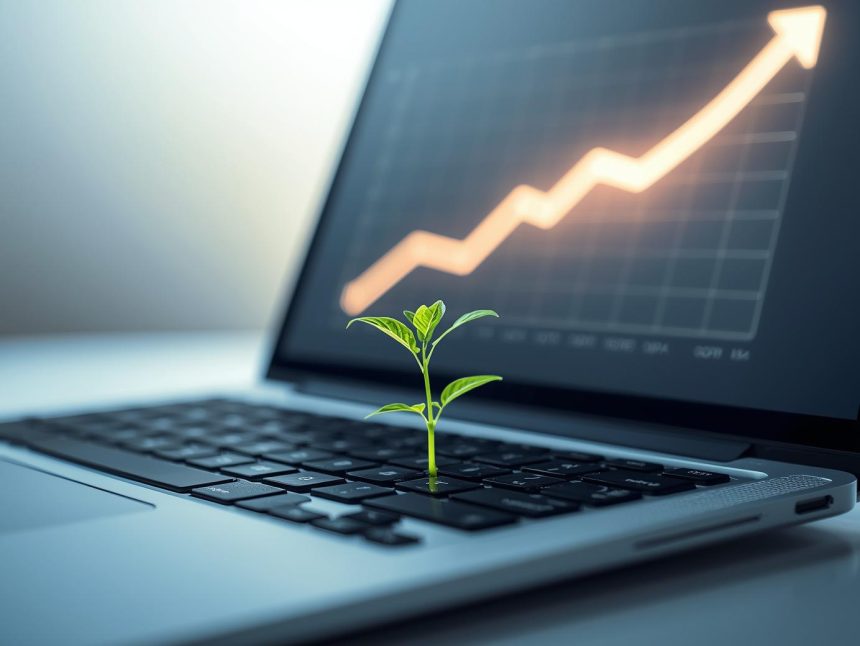Imagine a world where every ad you see online, every website you visit, and every post you scroll past helps the Earth instead of hurting it. That’s what sustainable marketing in digital marketing is all about. It’s not just selling stuff—it’s selling smart, with the planet and people in mind. Digital marketing is everywhere today, so it’s the perfect place to make a green difference. In this article, we’ll explore what sustainable marketing means online, why it’s a big deal, how it works, and where it’s headed. We’ll use real facts and simple examples to keep it clear and fun.
What’s Sustainable Marketing All About?
Sustainable marketing is when businesses promote their products in a way that’s good for the environment, fair to people, and still makes money. In digital marketing, it’s about using tools like websites, social media, and ads to share that message without waste or harm. It’s not only about “green” products like bamboo toothbrushes—it’s about the whole process being kind to the planet.
Think of it this way: regular marketing might push you to buy something cheap and toss it fast. Sustainable marketing says, “Hey, let’s sell this right, keep it honest, and not trash the Earth.” It’s a win for everyone.
Why It Matters Online
People care about the planet more than ever. A 2021 study found that 66% of people worldwide would pay extra for products from sustainable brands (NielsenIQ, 2021). That’s over half the world’s shoppers! Digital marketing reaches those people every day through phones and computers, making it a huge chance to show eco-friendly values.
But here’s the catch: digital marketing itself can be messy for the environment. All those websites and ads run on servers that use electricity—sometimes from dirty sources like coal. A 2019 report said the internet creates about 3.7% of global greenhouse gases, almost as much as airplanes (The Shift Project, 2019). Sustainable marketing wants to clean that up.
Plus, customers want brands they can trust. A 2021 IBM survey showed 57% of people would ditch a brand that’s not sustainable for a greener one (IBM Institute for Business Value, 2021). Online, where companies talk straight to us, building that trust is gold.
How to Make Digital Marketing Green
So, how do you do it? Here are some easy ways businesses are going green online.
1. Build Eco-Friendly Websites
Every time you visit a website, it uses energy. Big, flashy sites with tons of videos guzzle more power than simple ones. A tool called Website Carbon Calculator shows that the average webpage makes 1.76 grams of CO2 per visit (Website Carbon, 2021). But smart design—like fewer images or cleaner code—can cut that in half.
Companies can also pick green hosting, like GreenGeeks, which runs on wind or solar power. It’s a small switch with a big impact.
2. Smarter Social Media
Social media is huge for marketing, but it doesn’t have to be wasteful. Sustainable marketing means posting with a purpose—like sharing tips instead of just ads. Patagonia, the outdoor gear brand, uses Instagram to show how to fix old jackets instead of buying new ones. It’s less spammy and saves energy.
Young people love this. A 2022 study found 70% of Gen Z likes brands that push sustainability on social media (Deloitte, 2022). Quality over quantity works.
3. Lighten Up Ads
Online ads, especially videos, use a lot of energy. A 2021 report said digital advertising takes up a big chunk of the internet’s power (Ad Net Zero, 2021). Sustainable marketing makes ads lighter—think text or simple pictures instead of heavy videos. Tools like Google Ads can also target the right people, so ads don’t waste energy on folks who won’t click.
4. Keep It Real
Nobody likes being fooled. Sustainable marketing means telling the truth—no faking it with “greenwashing.” H&M got called out in 2022 for exaggerating how eco-friendly its clothes were, and people weren’t happy (BBC, 2022). Meanwhile, Allbirds shares real numbers on its website, like how much carbon its shoes make (Allbirds, 2023). Honesty pays off—a 2020 survey said 71% of people lose trust in brands that lie about being green (Edelman, 2020).
5. Spread Good Vibes
Digital marketing can do more than sell—it can support good causes. Seventh Generation, a cleaning brand, sends emails about living greener, not just pushing soap (Seventh Generation, 2021). It’s a way to connect and make a difference.
Why Bother? The Big Wins
Here’s why sustainable marketing rocks for businesses:
- Happy Customers: People love brands that care. Sustainable products grow faster than others, giving companies an edge (NielsenIQ, 2018).
- Save Cash: Lighter websites and smarter ads cut energy bills. A green site can lower hosting costs by up to 15% (Website Carbon, 2021).
- Look Good: Online, green brands get more likes and shares. People spread the word when they see real effort.
- Stay Ahead: New rules, like the EU’s Green Deal, are pushing for lower digital emissions by 2030 (European Commission, 2020). Starting now keeps you ready.
The Tough Stuff
It’s not all smooth sailing. Going green online has challenges:
- Costs Up Front: Green hosting or redesigns might cost more at first, tough for small businesses.
- Extra Work: Being sustainable takes time and planning—not every company’s ready.
- Mistake Risks: One greenwashing slip, and trust vanishes fast, like with H&M (BBC, 2022).
But with the right tools, these hurdles shrink.
Real Companies Doing It Right
Check out these brands nailing it:
- Patagonia: They cut digital ads to focus on stories—like fixing gear instead of buying new. Sales still climbed because people loved the vibe (Patagonia, 2022).
- Allbirds: Their site is light and fast, using way less energy, plus they share their carbon stats openly (Allbirds, 2023).
- Seventh Generation: Their emails teach eco-tips alongside selling, building a loyal crowd (Seventh Generation, 2021).
Where’s This Going?
The future’s bright—and green. Experts think sustainability will shape half of digital marketing by 2030 (Saura et al., 2020). Artificial intelligence (AI) will help, making ads super-targeted to cut waste. Tools like HubSpot already use AI for this.
Social media’s evolving too. Influencers who care about the planet will team up with brands more, spreading the message. And customers? They’ll demand proof. Millennials especially want brands to back up green claims online (IBM Institute for Business Value, 2021). By 2025, that push will be even stronger.
How to Start Now
Want in? Here’s a quick plan:
- Test Your Site: Use Website Carbon Calculator to check your footprint.
- Simplify: Cut the fluff—lighter sites and ads save energy.
- Be Honest: Share real stories online about your green steps.
- Go Green: Pick eco-hosting or partners who care.
- Check Progress: Watch your energy use and customer feedback.
Wrapping Up
Sustainable marketing in digital spaces—green clicks—can change the game. It’s about selling smart, saving the planet, and keeping people happy. Real data shows customers want it, tools make it doable, and the future needs it. Whether you’re a tiny startup or a big brand, every green click counts. Let’s make digital marketing a superhero for the Earth—one step at a time.
References
Ad Net Zero. (2021). The environmental impact of digital advertising. https://adnetzero.com
Allbirds. (2023). Our sustainability journey. https://www.allbirds.com/pages/sustainability
BBC. (2022, July 5). H&M accused of greenwashing over sustainability claims. https://www.bbc.com/news/business-62052491
Deloitte. (2022). 2022 Gen Z and millennial survey. https://www2.deloitte.com/global/en/pages/about-deloitte/articles/genzmillennialsurvey.html
Edelman. (2020). 2020 Edelman trust barometer. https://www.edelman.com/trust/2020-trust-barometer
European Commission. (2020). The European Green Deal. https://ec.europa.eu/info/strategy/priorities-2019-2024/european-green-deal_en
IBM Institute for Business Value. (2021). Meet the 2021 consumers driving change. https://www.ibm.com/thought-leadership/institute-business-value/report/consumer-2021
NielsenIQ. (2018). The sustainability imperative. https://nielseniq.com/global/en/insights/report/2018/sustainability-imperative
NielsenIQ. (2021). Consumer sustainability survey 2021. https://nielseniq.com/global/en/insights/report/2021
Patagonia. (2022). Our impact. https://www.patagonia.com/impact
Saura, J. R., Palos-Sanchez, P., & Rodríguez Herráez, B. (2020). Digital marketing for sustainable growth: Business models and online campaigns using sustainable strategies. Sustainability, 12(3), 1003. https://doi.org/10.3390/su12031003
Seventh Generation. (2021). Our commitment to sustainability. https://www.seventhgeneration.com/sustainability
The Shift Project. (2019). Lean ICT: Towards digital sobriety. https://theshiftproject.org/en/report-lean-ict
Website Carbon. (2021). How is your website impacting the planet? https://www.websitecarbon.com















